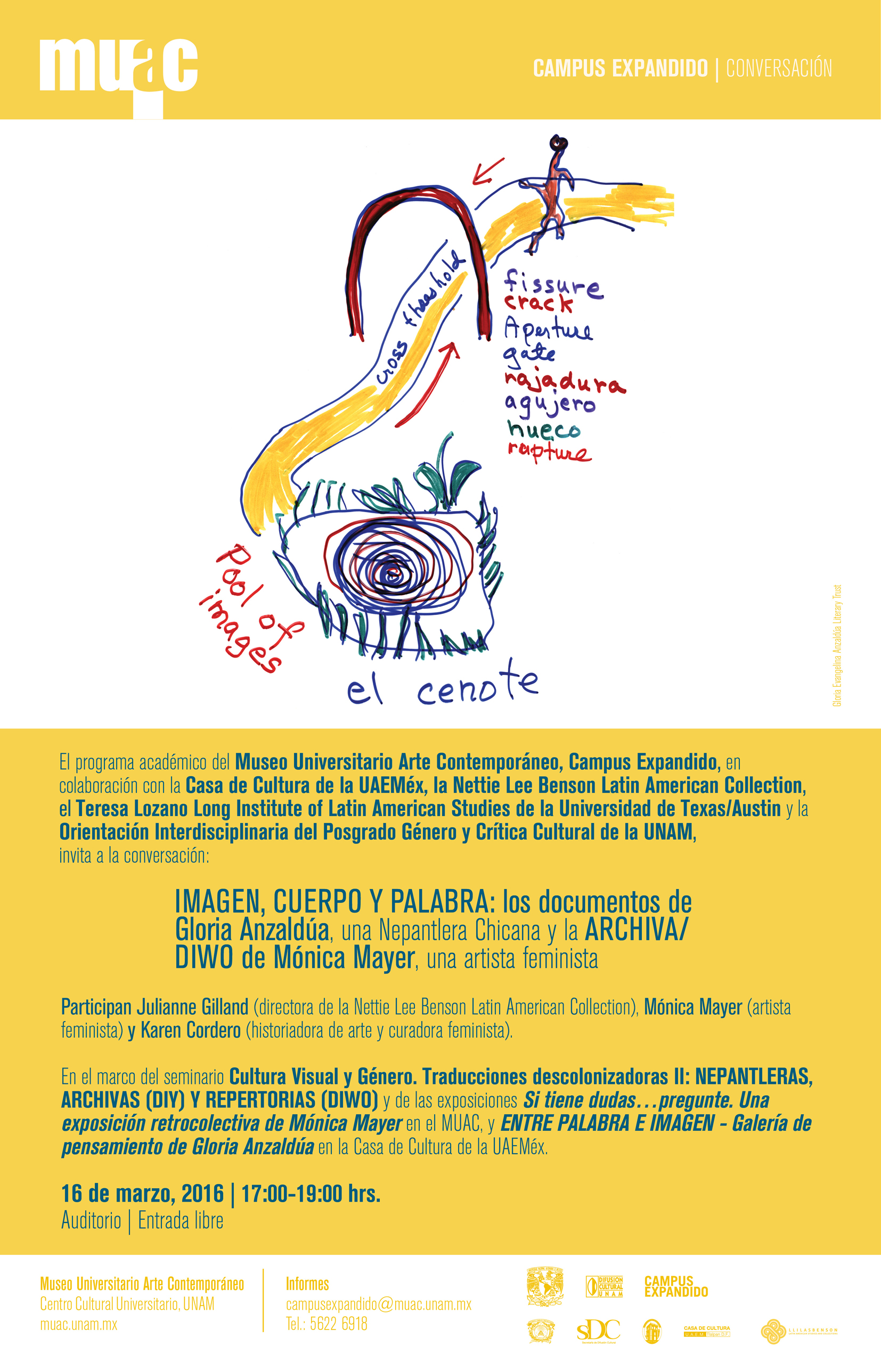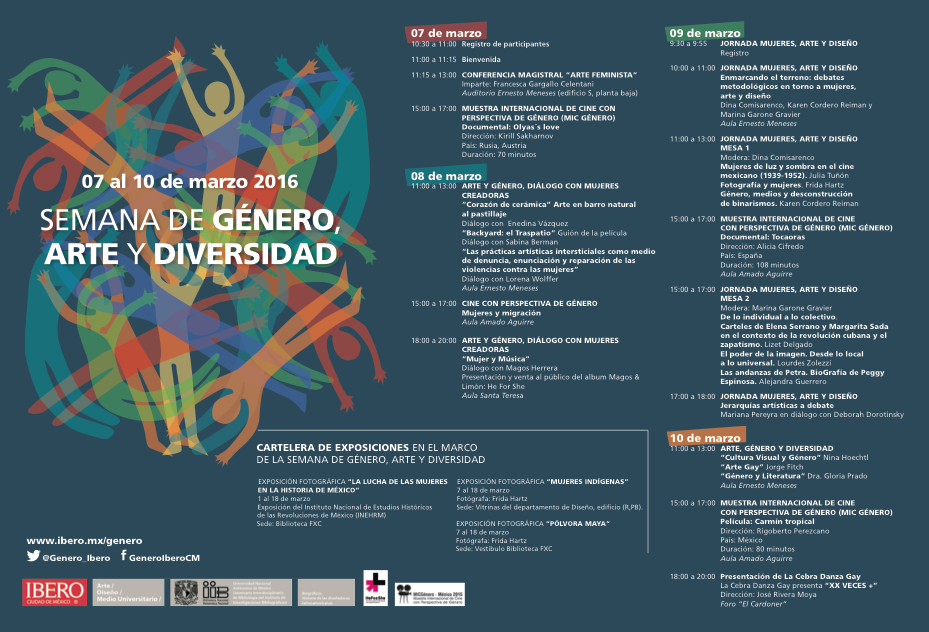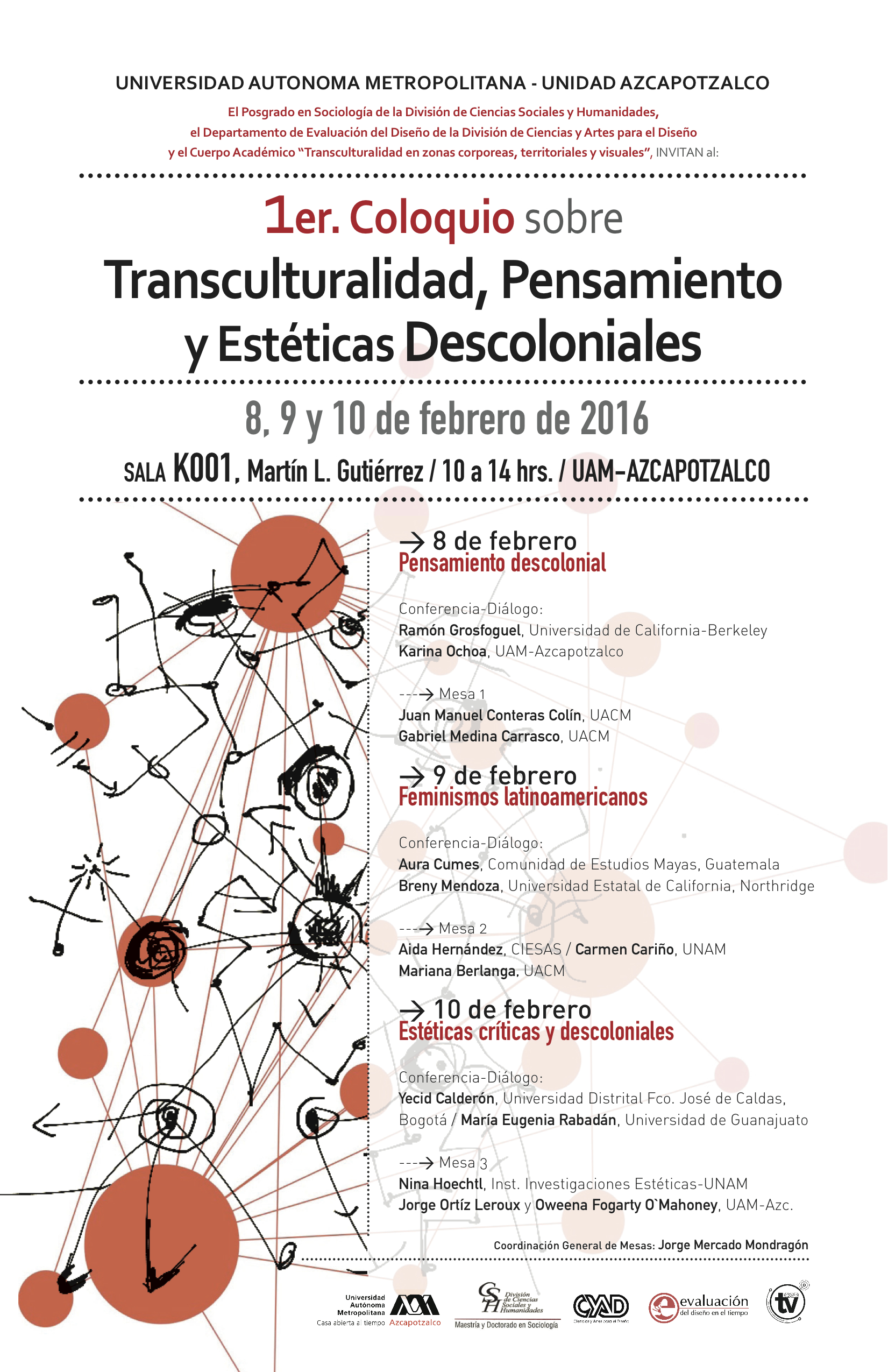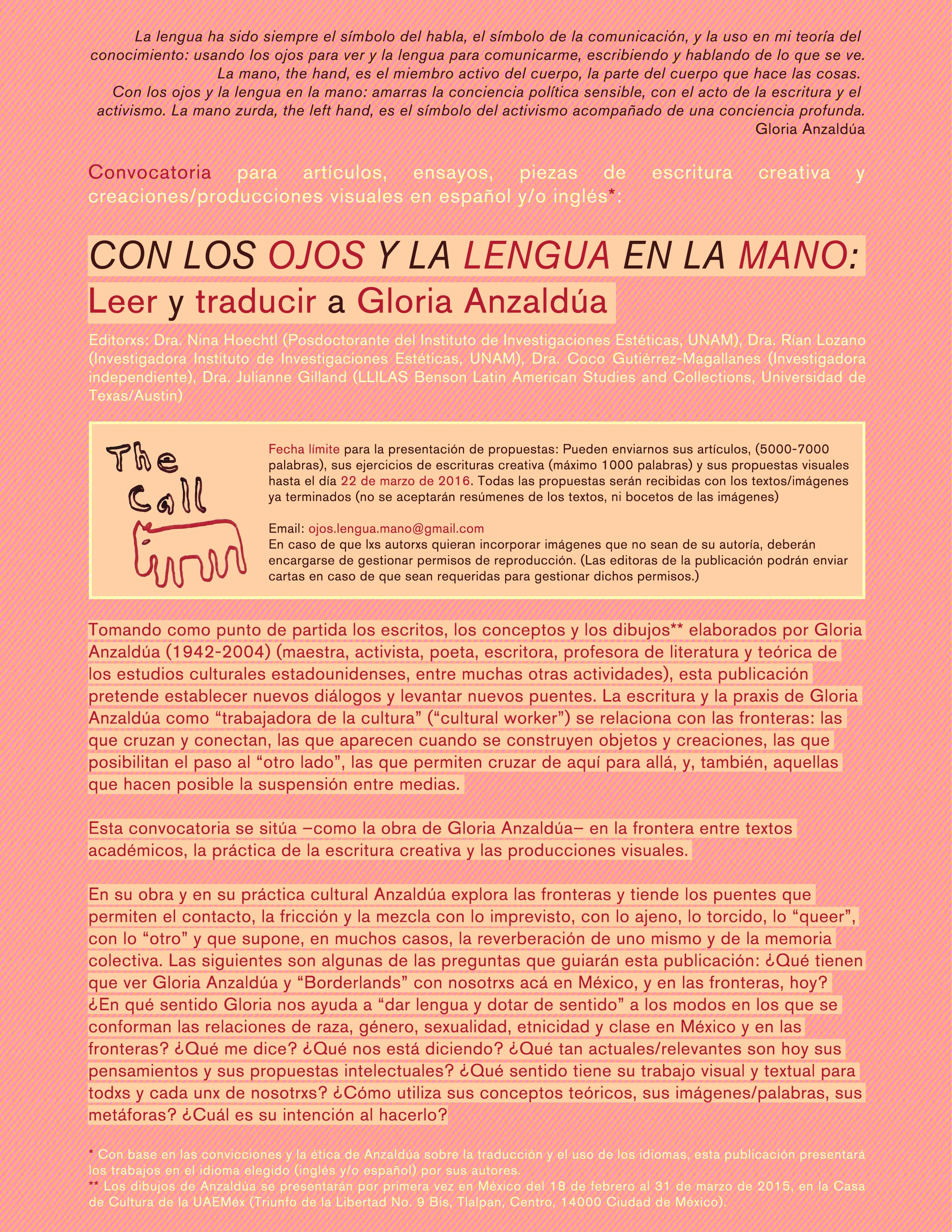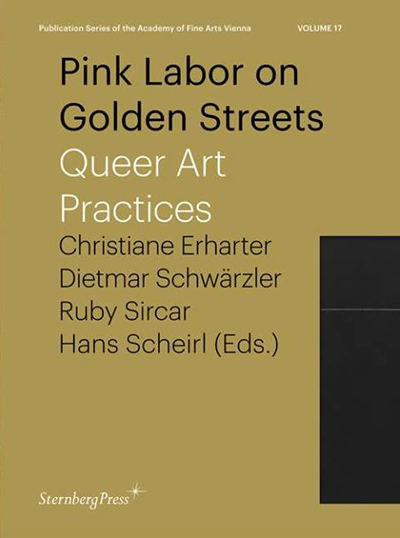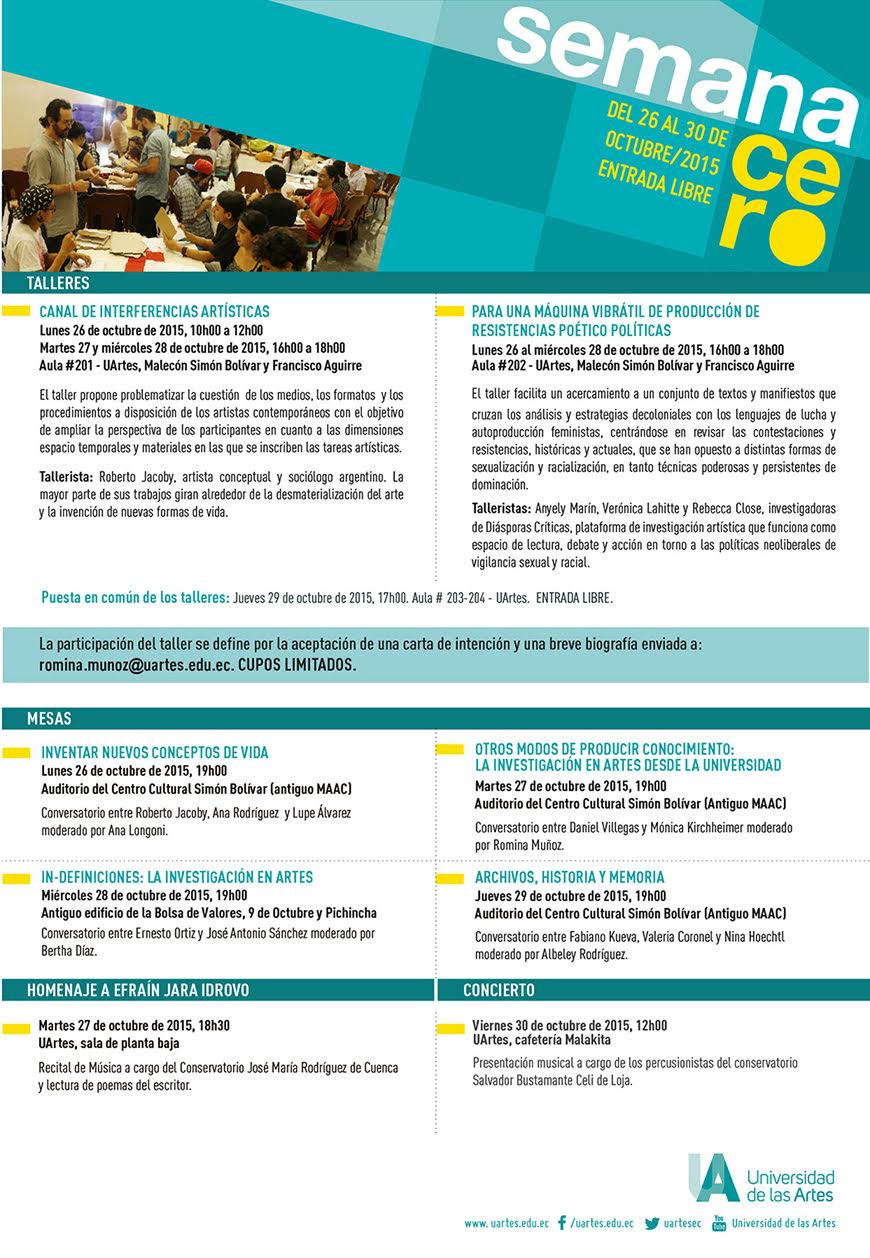Blog
Exhibición y presentación @ BEYOND BORDERS
Presentación y exhibición A(R)MANDO VO(I)CES Una galería de pensamientos de Gloria Anzaldúa con Verena Melgarejo Weinandt en el marco de la conferencia internacional BEYOND BORDERS: Literaturas y culturas transfronterizas mexicanas y chicanas
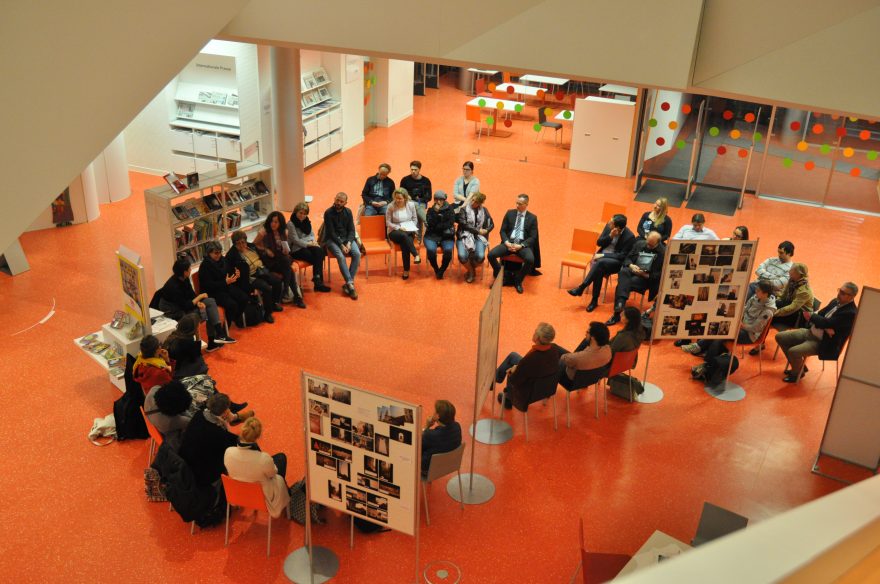
Presentación de video «MY GÜERX SKIN HURTS HORRIBLY. -Sí, cómo no.», SGFA 2016
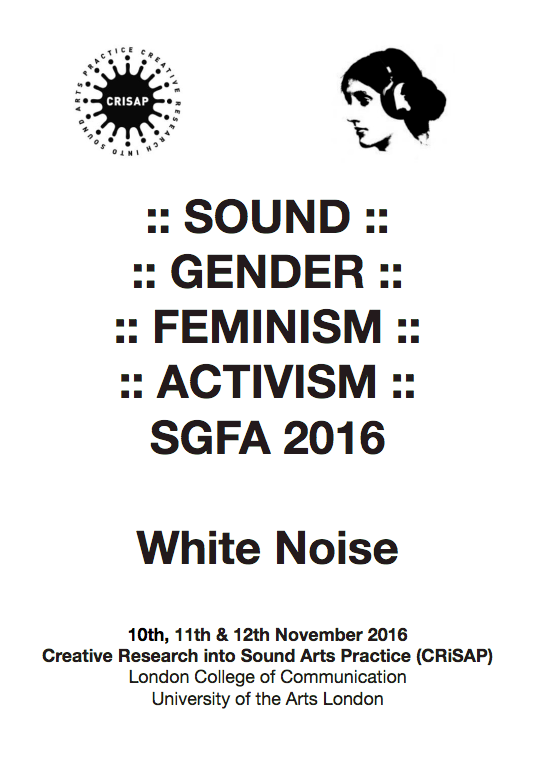
El 11 de noviembre de 2016 INVASORIX participó con la presentación MY GÜERX SKIN HURTS HORRIBLY. -Sí, cómo no. en SOUND GENDER FEMINISM ACTIVISM SGFA 2016 White Noise, University of the Arts London.
Siendo feministas-cuir y estando inmersas en un patriarcado capitalista racista partidario de la superioridad blanca —como nuestra amiga imaginaria bell hooks le llama con tanta precisión— intentamos intervenir en su ruido blanco con el fin de interrumpir su chillante zumbido aparentemente tranquilizante aunque adormecedor. Por otra parte, en el contexto mexicano, al menos a la mitad de nuestro grupo se le lee y se le aborda como güerxs: la palabra puede referirse a personas de cabello rubio y/o piel clara y/o supuesto estatus social y cultural «superior», por lo tanto también se podría utilizar güerear con el fin de conseguir algo.
Al asociar el ruido blanco con una potencia opaca y subaudible, que organiza jerárquicamente los cuerpos, las tierras, los recursos y el acceso, entre otros, intentamos abordar estas complejas intersecciones, así como las dinámicas de poder, los puntos ciegos, y diferentes privilegios, raciales, de clase y educación dentro de nuestro grupo en una canción de reggaetón: ¿Cómo estos afectan, transforman, desafían, obstaculizan y disminuyen las relaciones, los diálogos, el trabajo y los riesgos éticos, políticos y creativos que tomamos? ¿Cómo podría nuestra canción de reggaetón ser un terreno fértil que provoque la potenciación feminista-cuir y un gesto significativo descolonizador, que desafíe su asociación esencializante de «latinx» y «caribeñx» y su relación intrínseca con el baile, lo físico y la sexualidad?
Ensayo «Wrestling With Burlesque, Burlesquing Lucha Libre,» in Performance and Professional Wrestlig
Mi ensayo «Wrestling With Burlesque, Burlesquing Lucha Libre» (en inglés) es parte de Performance and Professional Wrestling, coordinado por Broderick Chow, Eero Laine, Claire Warden y con textos de Keiko Aiba, Stephen di Benedetto, Janina Bradbury, Broderick Chow, Morgan Daniels, Carrie Dunn, Jon Ezell, Stephen Greer, Jamie Lewis Hadley, Nina Hoechtl, Charles Hughes, Eero Laine, Heather Levi, Laura Katz Rizzo, Sharon Mazer, Nicholas Porter, Claire Warden, Nicholas Ware (London and New York: Routledge, 2017)
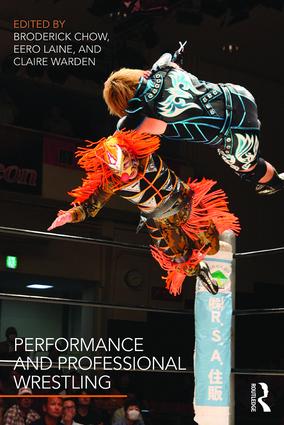
Performance and Professional Wrestling is the first edited volume to consider professional wrestling explicitly from the vantage point of theatre and performance studies. Moving beyond simply noting its performative qualities or reading it via other performance genres, this collection of essays offers a complete critical reassessment of the popular sport.
Topics such as the suspension of disbelief, simulation, silence and speech, physical culture, and the performance of pain within the squared circle are explored in relation to professional wrestling, with work by both scholars and practitioners grouped into seven short sections:
Audience
Circulation
Lucha
Gender
Queerness
Bodies
Race
A significant re-reading of wrestling as a performing art, Performance and Professional Wrestling makes essential reading for scholars and students intrigued by this uniquely theatrical sport.
Exhibición: ENTRE PALABRA E IMAGEN Galería de pensamiento de Gloria Anzaldúa, 17 de marzo-16 de abril, Casa de Cultura/U.A.E.M., Tlalpan, Ciudad de México
ENTRE PALABRA E IMAGEN
Galería de pensamiento de Gloria Anzaldúa
Inauguración: 17 de marzo, 2016, 17:30hrs
Duración de la exposición: 18 de marzo – 16 de abril 2016
Casa de Cultura de la U.A.E.M. en Tlalpan
Triunfo de la Libertad #9, Ciudad de México
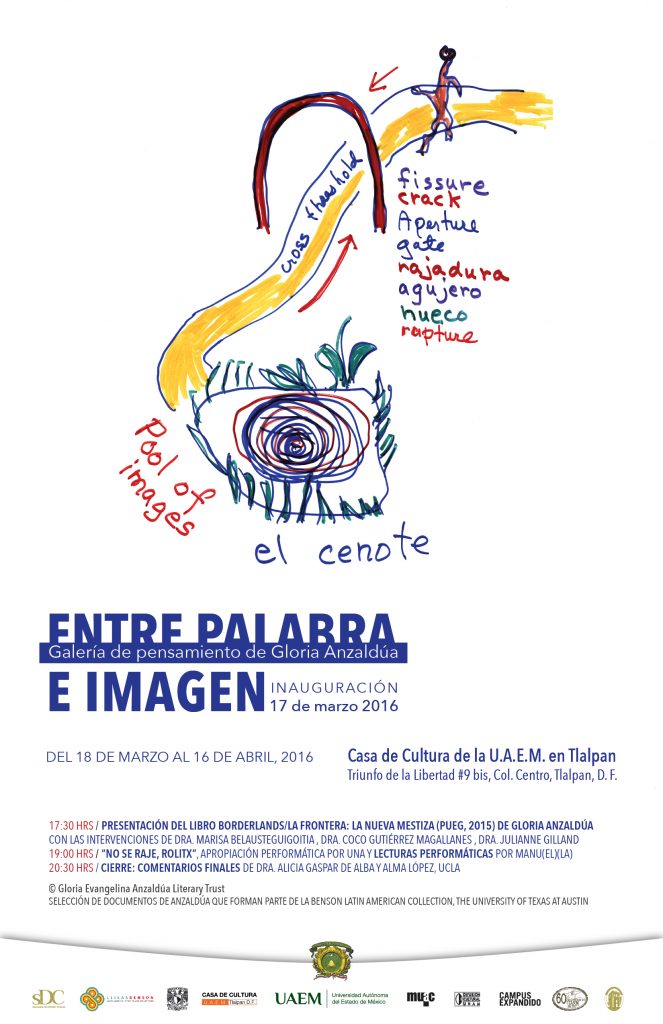
Programa de la inauguración
17:30 hrs
Presentación del libro
Borderlands/La frontera: la nueva mestiza (PUEG, 2015)
de Gloria Anzaldúa
con las intervenciones de
Dra. Marisa Belausteguigoitia (Facultad de Filosofía y Letras, UNAM)
Dra. Coco Gutierrez-Magallanes (Investigadora independiente)
Dra. Julianne Gilland (LLILAS Benson Latin American Studies and Collections, Universidad de Texas/Austin)
19:00 hrs
“No se raje, rolitx”, apropiación performática por Una
Lecturas performáticas por MANU(EL)(LA)
20:30 hrs
Cierre: Comentarios de la Dra. Alicia Gaspar de Alba y artista Alma López (UCLA)
Una imagen es un puente entre la emoción evocada y el conocimiento consciente; las palabras son los cables que sostienen el puente. Las imágenes son más directas, más inmediatas que las palabras y más cercanas al inconsciente. El lenguaje de la imagen precede al pensamiento en palabras; la mente metafórica precede a la conciencia analítica.
Gloria Anzaldúa, Borderlands: the new mestiza = La frontera, 1987
Cuando estudié pintura y literatura, descubrí que podía crear universos concretos. Más bien no los creé; yo era su conductora, su canal.
Gloria Anzaldúa, “Creativity and Switching Modes of Consciousness,” 1986
ENTRE PALABRA E IMAGEN. Galería de pensamiento de Gloria Anzaldúa, expuesta por primera vez al sur del Río Bravo, nos confronta inevitable y creativamente con las siguientes preguntas: ¿Cómo leemos y retomamos el trabajo visual y textual de Anzaldúa hoy, acá en México? ¿Qué papel juegan en las fronteras que habitamos, en las que vivimos y a las que sobrevivimos? ¿En qué sentido Anzaldúa nos ayuda a dar lengua y dotar de sentido a los modos en los que se conforman las relaciones de raza, etnicidad, género, sexualidad y clase en México y en las fronteras? ¿Qué nos está diciendo/mostrando? ¿Qué tan vigentes y relevantes son hoy sus pensamientos y sus propuestas intelectuales y visuales?
Autoproclamada «chicana, tejana, de clase trabajadora, poeta tortillera-feminista, escritora-teórica», Gloria Anzaldúa se vio a sí misma como una nepantlera, como alguien que navega en el espacio liminal entre mundos, identidades y formas de conocimiento. Así como el movimiento fluido entre el inglés, el español y el náhuatl era central para la enseñanza y la escritura de Anzaldúa, también lo eran la interacción entre las palabras y las imágenes como elemento esencial de su propia expresión.
Estas palabras e imágenes presentadas por primera vez en México, son parte de los dibujos, notas y diagramas que Anzaldúa presentó en talleres y conferencias por todo Estados Unidos. Algunos materiales no están fechados pero muchos fueron creados durante uno de los períodos más activos de su carrera como docente, a mediados de la década de 1990.
Exhibición: Uncanny Materials, 10 de marzo-16 de mayo, 2016, xhibit
Uncanny Materials | Foundational Moments of Art Education
Opening | 10.03.2016, 7.00 p.m.
Exhibition dates | 11.03.2016 – 16.05.2016
Venue | Academy of Fine Arts Vienna, main building, Schillerplatz 3, 1010 Vienna, xhibit
A curatorial exhibition, research and education project
Opening hours: Tue–Sun, 10.00 a.m.–6.00 p.m., admission free
Special opening hours: 28.03.2016 (Easter Monday), 01.+05.05.2016 and 16.05.2016 (Whit Monday) / 10.00 a.m.–6.00 p.m.
Opening: Thursday, March 10, 2016, 7:00 p.m.
Welcome address: Eva Blimlinger, Rector of the Academy of Fine Arts Vienna
Introduction: Elke Krasny and Barbara Mahlknecht, Institute for Education in the Arts, Studio of Art and Education
Curators: Elke Krasny and Barbara Mahlknecht
Exhibition design in collaboration with Alexander Ach Schuh
With contributions by
Tal Adler/Friedemann Derschmidt/Elisabeth Samsonow/Karin Schneider/Anna Szöke/Niko Wahl, Anna Artaker, Eva Blimlinger, Ramesch Daha, Zsuzsi Flohr/Benjy Fox-Rosen/Eduard Freudmann/Eva Reinold/Luisa Ziaja, Lena Rosa Händle, Minna L. Henriksson, Belinda Kazeem-Kaminski, Gila Kolb, Martin Krenn, Ina Markova/Rosemarie Burgstaller/Sophie Bitter-Smirnov, Verena Pawlowsky, Sabine Plakolm, Birgit Peter, Dirk Rupnow, Hansel Sato, Sekretariat für Geister, Archivpolitiken und Lücken (Nina Höchtl und Julia Wieger), Anna Schürch, Bernadette Settele, Nora Sternfeld, Suely Rolnik, Wer hat Angst vor dem Museum? (Imayna Caceres/Pêdra Costa/Verena Melgarejo Weinandt).
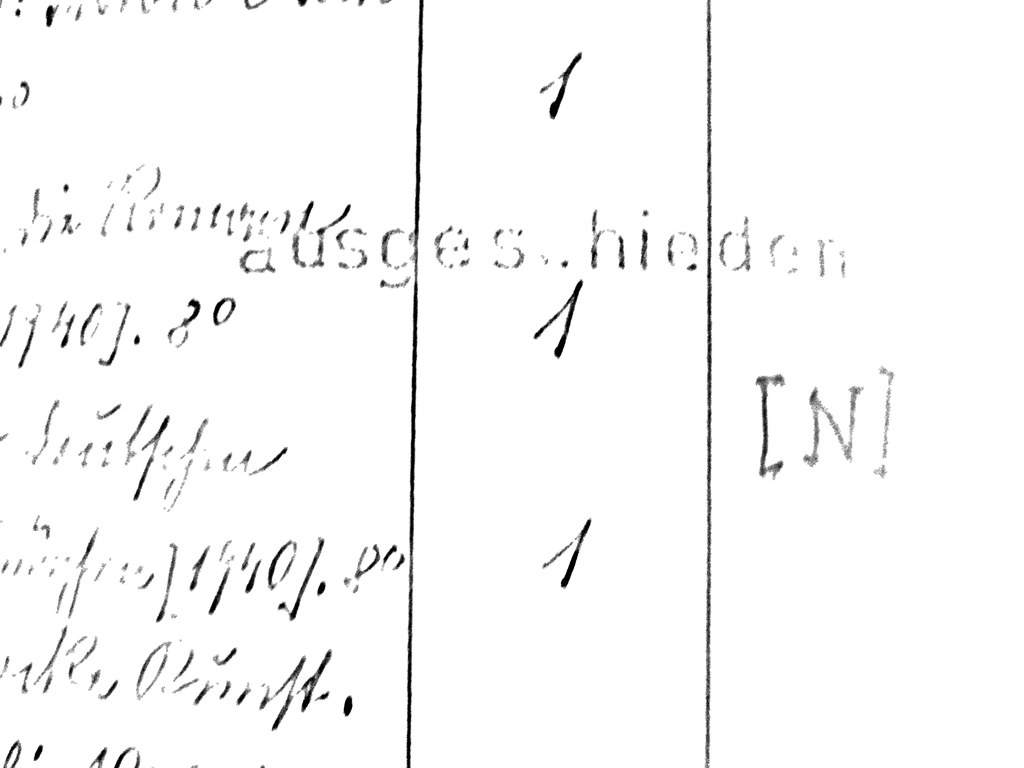
Book inventory Vol. 3, 1947, © University Library of the Academy of Fine Arts Vienna
On July 9, 1941, a decree stipulating the foundation of a “master school for art education and the training of secondary school art teachers” went out from the Reichsministerium für Wissenschaft, Erziehung und Volksbildung (Reich Ministry for Science, Education, and People’s Education) in Berlin to the Academy of Fine Arts Vienna. The beginning of the institutionalization of a program for art teachers at the Academy, which is still largely unappraised seventy-five years later, has now been made the subject of a curatorial exhibition, research and education project.
Based on research by the historians Ina Markova, Rosemarie Burgstaller, and Sophie Bitter-Smirnov, the project’s curators, Elke Krasny and Barbara Mahlknecht, have conceived of an open archive for the exhibition. This installation allows for an understanding how National Socialism informed art education: materials from the Academy’s University Archive – personnel sheets, lists of students, curricula, exam regulations, minutes of professorial staff meetings, budgets, lists of master school awards and materials to be provided – document the institutional routine.
Activists and artists, many of whom have studied at the Academy of Fine Arts Vienna or are teaching there now, were invited to present works or develop performances related to the subject. The artists’ positions articulate activist interventions into the memory of institutions, relate to the standardization and disciplining of bodies through education, and reveal how women’s politics were implicated in National Socialism. Some of the works reflect present-day changes in the realm of “multidirectional memory” (Michael Rothberg) and the meaning of “migrants’ situated knowledge” (Ayse Güleç) in regard to politics of history.
On April 20 and 21, 2016, an international symposium with lectures, talks, and workshops will explore issues of institutional memory, National Socialist educational policy, the connections between politics of remembrance and artistic practices and question critically hegemonic histories in the field of art education.
Uncanny Materials
Program
Wed, March 16, 2016, 4:00 p.m., xhibit
A Look Back into the Museum
Performance lecture with Wer hat Angst vor dem Museum? (Imayna Caceres, Pêdra Costa, and Verena Melgarejo Weinandt)
(English)
Tue, April 5, 2016, 1:30 to 5:30 p.m., xhibit
In Haunted Archives: (Post-)National Socialist Times, Decolonial Futures
Secretariat for Ghosts, Archival Politics, and Gaps (Nina Höchtl and Julia Wieger)
Workshop (English)
Wed, April 20, 2016, 9:30 a.m. to 9:00 p.m.
Thur, April 21, 2016, 10:00 a.m. to 4:00 p.m.
Studio Building of the Academy, Multi-Purpose Space
Turning (to) the Archive. Institutional Histories, Educational Regimes, Artistic Practices, and Politics of Remembrance
Symposium: lectures, discussions, and workshops by contributions from Tal Adler/Friedemann Derschmidt/Elisabeth Samsonow/Karin Schneider/Anna Szöke/Niko Wahl, Eva Blimlinger, Zsuzsi Flohr/Benjy Fox-Rosen/Eduard Freudmann/Eva Reinold/Luisa Ziaja, Minna L. Henriksson, Gila Kolb, Elke Krasny, Martin Krenn, Barbara Mahlknecht, Verena Pawlowsky, Sabine Plakolm, Birgit Peter, Dirk Rupnow, Anna Schürch, Bernadette Settele, Nora Sternfeld, Suely Rolnik.
Tue, May 3, 2016, 3:00 to 5:30 p.m., xhibit
The course Kunst, Öffentlichkeit und Geschichtspolitik (Art, Public Sphere, and Politics of History) visits the exhibition Belinda Kazeem-Kaminski (German).
Tue, May 10, 2016, 5:00 p.m., gathering place: x hibit
1941: A Politics-of-History Walk through Vienna
With students from the course Kunst und Öffentlichkeit (Art and the Public Sphere) taught by Elke Krasny (German)
Wed, May 11, 2016, 11:00 a.m., xhibit
The Missing Monument – Commemoration in Progress
Workshop as part of Zsuzsi Flohr’s course Commemoration in Progress (English)
Fri, May 13, 2016, 4:00 p.m., xhibit
Curators’ tour (German/English)
Special thanks for their support and cooperation extend to
Eva Blimlinger and Andrea B. Braidt; the University Archives, the University Library and the Graphic Collection of the Academy, as well as the many others who have supported this project.
“To Think with the Whole Body”, Katia Sepúlveda en conversación con Nina Hoechtl, Band 17 PINK LABOR ON GOLDEN STREETS. QUEER ART PRACTICES
«The video Wish (2010) is projected on two screens and the song Black Wish by The Last Poets fills the small seminar room of the University Program of Gender Studies (PUEG) at the National Autonomous University of Mexico (UNAM). All of us, participants of the seminar Del queer al cuir: desplazamiento geopolítico sur y desde las periferias / From Queer to Cuir: Geopolitical Displacement from the South and the Peripheries, organized by the poet, essayist and performer Sayak Valencia, rock our bodies to the song’s rhythm and at the end of the video we start a heated debate about gloves, white, brown, black, feminine, masculine, trans hands, fisting and post-porn. I am sitting – by chance and unknowingly – close to Katia Sepúlveda, the Chilean artist whose video has just been presented. She has been living in Germany over the last nine years. Soon enough we get to talk, I thank her for the presentation, and three years later I write her an email, asking if she would be interested in a conversation for a publication in Europe. A few hours later I find her consent in the inbox. The following exchange came about through several emails in a hybrid of German and Spanish, revisions and translations, over a period of one month from the middle of February to the middle of March 2015.»
Se puede leer toda la conversación en inglés en
Schriftenreihe der Akademie der bildenden Künste Wien Band 17
PINK LABOR ON GOLDEN STREETS. QUEER ART PRACTICES
Hg. Christiane Erharter, Dietmar Schwärzler, Ruby Sircar, Hans Scheirl
Pink Labor on Golden Streets: Queer Art Practices is particularly concerned with combining, juxtaposing, or playing off various artistic strategies where form and politics intervene. Two artistic attitudes, often perceived as divergent, are described here: the choice of form attributed to political issues versus political stances dictating the question of form. This book sheds lighton contradictory standpoints of queer art practices, conceptions of the body, and ideas of “queer abstraction,” a term coined by Judith Jack Halberstam that raises questions to do with (visual) representations in the context of gender, sexuality, and desire.
Autorxs: Madeleine Bernstorff, Cana Bilir-Meier, Kaucyila Brooke, Anna Daučíková, Vaginal Davis, Christiane Erharter, David J. Getsy, Jack Halberstam, Harmony Hammond, Stefan Hayn, Nanna Heidenreich, Daniel Hendrickson, Werner Hirsch, Nina Hoechtl, G. B. Jones, Jakob Lena Knebl, Michael Lucid, Ulrike Müller, Barbara Paul, Johannes Porsch, Karol Radziszewski, Raed Rafei, Roee Rosen, Hans Scheirl, Dietmar Schwärzler, Katia Sepúlveda, William J. Simmons, Ruby Sircar, Eliza Steinbock, Ginger Brooks Takahashi
